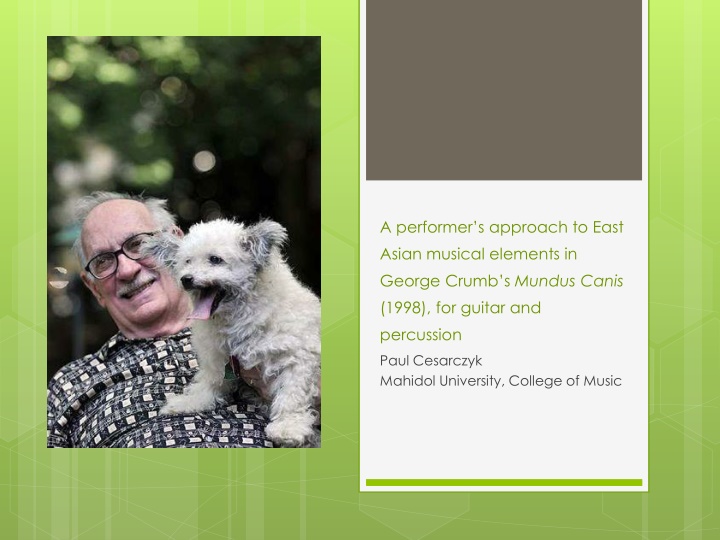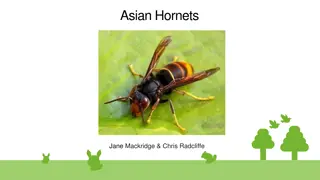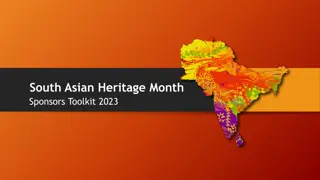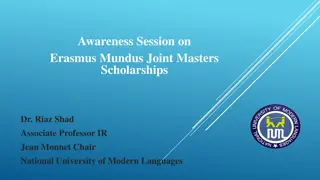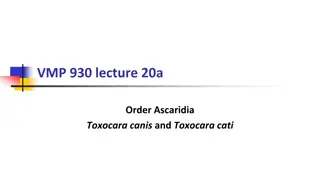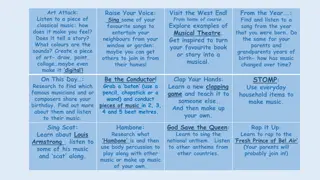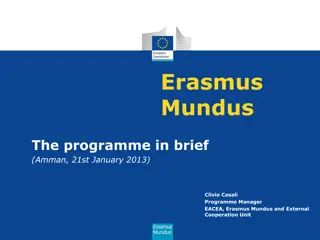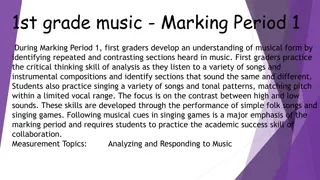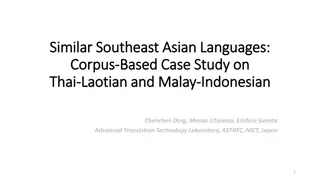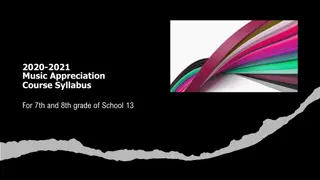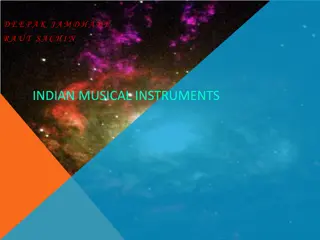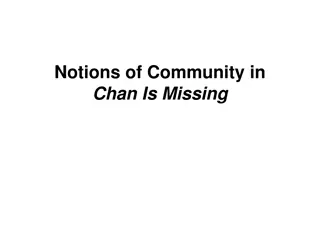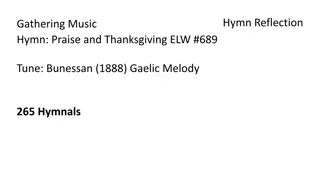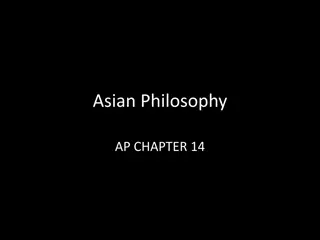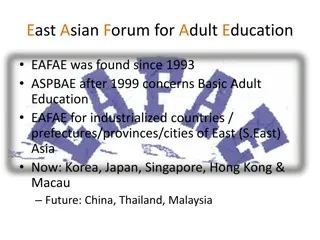George Crumb's Exploration of East Asian Musical Elements in Mundus Canis
George Crumb, a renowned composer, delves into incorporating East Asian musical elements in his work "Mundus Canis." By drawing inspiration from diverse music traditions worldwide, Crumb exemplifies a synthesis of various musical influences, reflecting a global musical landscape. Through interviews and insights, Crumb's openness to cross-cultural musical exchanges and his profound connection to nature in music composition are highlighted.
Download Presentation

Please find below an Image/Link to download the presentation.
The content on the website is provided AS IS for your information and personal use only. It may not be sold, licensed, or shared on other websites without obtaining consent from the author.If you encounter any issues during the download, it is possible that the publisher has removed the file from their server.
You are allowed to download the files provided on this website for personal or commercial use, subject to the condition that they are used lawfully. All files are the property of their respective owners.
The content on the website is provided AS IS for your information and personal use only. It may not be sold, licensed, or shared on other websites without obtaining consent from the author.
E N D
Presentation Transcript
A performers approach to East Asian musical elements in George Crumb s Mundus Canis (1998), for guitar and percussion Paul Cesarczyk Mahidol University, College of Music
(1) Explain how a performer can open new avenues of Interpretation by reaching into unfamiliar musical territory (2) Establish a solid link between George Crumb and his use of East Asian musical materials (3) Demonstrate how GC uses Asian elements in his music, specifically Mundus Canis
George Crumb: I sense that so far in the twentieth century, synthesis seems to be the big thing. Composers like Mahler, Debussy and Ives were all involved with combining things. They were anti-purists, in a sense. They were combining all the music they ever knew, or music that meant something to them, and they would put it in the same piece. And that process is still going on. Of course, we still have the purist approach, too, that exists or co-exists. But I rather believe that the world is, in a way, coming together, in the sense that all the musics might influence a composer, even if he lives in Media, Pennsylvania. It s possible that music all the way around the world can influence his own music. Telephone interview with Bruce Duffie, 1988 (http://www.bruceduffie.com/crumb2.html)
George Crumb: Now we re submerged the whole world is kind of one world musically. Movies or traveling groups of performers from Bali, we hear these sounds or we travel ourselves and hear this music other places . The sounds are in our ear. There are wonderful collections of recordings. Even as a college student I heard in the Folkways Series music from Africa, the Orient, or South America and I never forgot these sounds. These are things so beautiful in their own right. I thought maybe they can be used in Western music and in fact many of these things have been introduced by composers over these last several decades . When Debussy uses the crotales (antique cymbals) in his [Prelude to the] Afternoon of a Faun, it s a beautiful sound and it seems to fit just that moment. Its not a gratuitous effect its organically related to his conception, it s just the right sound . The whole world is getting condensed and all these possibilities are there. -Conversation with David Starobin, Library of Congress, April 28, 2011. https://www.youtube.com/watch?v=cVWfa0P9CXU
George Crumb: I ve also heard a lot of Eastern Music. I visited China some years ago and they wanted to make me an honorary Chinese composer because they heard something in my music that sounded Chinese, something I d unconsciously incorporated, I guess. That s what we are today; we re composites. Our ears are open geographically. I think of music as being so intimately connected with nature to start with. Composers who influenced my music wrote nature music. Debussy was a composer who was refracting through his aural prism the sounds of nature, replicating the rhythm of nature. -Interview with Thomas Riis at the George Crumb Festival in Boulder, Colorado, October 10, 1992. (http://www.colorado.edu/amrc/sites/default/files/attached-files/0506-1993-003-00- 000004.pdf)
From Yanoi Uno Everrett, Locating East Asia in Western Art Music (2004) Compositional Strategies (post 1945) Transference (1) Quoting culture through extra-musical means (2) Borrowing aesthetic approaches without sounding Asian (3) Evoking Asian sensibilities without explicit borrowing (4) Quoting melodies by way of collage Syncretism (1) Transplant East Asian musical attributes such as timbre, articulation, and scale systems into their western counterparts (2) Juxtaposition of western/eastern instruments or ensembles into the same composition Synthesis (1) Process of transforming Western and Eastern musical systems into a hybrid musical idiom
Identifying the Eastern in composition: accompanying material, i.e., title, accompanying poetry, introductory statement, etc. intervallic relationships: pentatonic, microtonal melodic contour overall structure rhythmic or tonal repetition tempo and spacing of notes timbral differentiation of individual notes articulation and embellishment Notation improvisatory aspects pitch definition non-traditional use of dynamics
Jo-ha-kyu (1) Important concept in Japanese aesthetics music, cinema, martial arts, but especially the Noh Theatre (2) Introduction scattering rushing (3) Jo: expectation, exploration of the performing space (4) Ha: unfolding of a musical gestural idea (5) Kyu: culmination of the accelerando (6) Affects the tempo with which the piece is played From Akira Tamba, Aesthetics in the Traditional Music of Japan (1976): controlling the speed of the development, the intensity and the linking of Successive phrases which, in the Noh Theatre for example, move imperceptably from intertia to a quick movement with dynamism becoming apparent.
Example of Jo-ha-kyu from the opening of Crumbs Mundus Canis:
